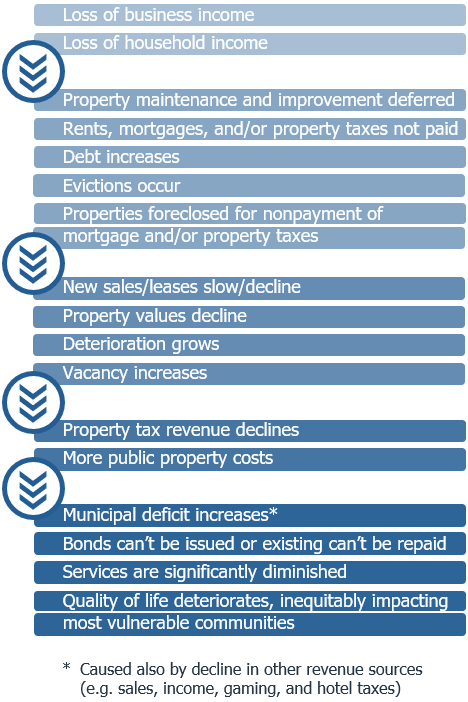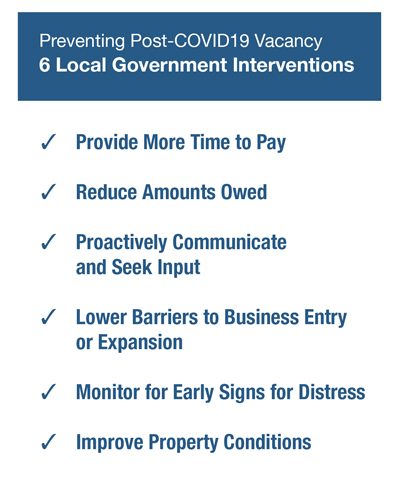Preventing Post-COVID-19 Vacancy: 6 Interventions Local Governments Should be Thinking About Now
April 20, 2020

We are still many months away from fully understanding the public health and economic fallout from COVID-19. However, history can provide some foresight into how this crisis may impact community stability and what actions local governments could examine now to mitigate these impacts.
Discriminatory and unjust policies have exposed individuals and their communities to a grimmer COVID-19 prognosis based on their race and income. For individuals, lingering health and economic inequities have resulted in black residents experiencing disproportionately higher death rates. At the local level, having borne the brunt of decades of systematic disinvestment, low-income communities and communities of color face a far more difficult economic recovery.
While local governments have pursued aggressive, proactive steps to stem the spread of the virus, they also need to begin exploring ways to prevent or mitigate the destabilizing community impacts.
How might COVID-19 impact property vacancy and community stability?
Today’s mandated and elective stay-at-home practices, which are appropriately aimed at reducing the spread of COVID-19, have led to an immediate, deep downturn in economic activity and business and personal income. Current indications are that this decline will last many months, and a portion of businesses and jobs permanently lost.
With insufficient and unpredictable income, property maintenance and rent, mortgage, and property tax payments will decrease. Fed by continued economic decline, this will lead to weaker market demand and a subsequent fall in property values.
This erosion of the commercial and residential real estate markets will ultimately lead to property deterioration and vacancy, which serves to further weaken demand, which in turn is likely to lead to more deterioration and vacancy.
What can local governments do now?
As this vicious cycle churns, cascading social impacts of deteriorated and vacant properties emerge – declines in family wealth and mental and personal health and increases in crime and fire, all of which lead to greater municipal costs and further instability.
But what if there was a way to minimize future vacancy? What are the things local leaders should consider now?
There is no single, silver bullet nor a one-size-fits-all policy solution to prevent property deterioration and vacancy. The right mix of interventions will depend on a community’s long-term vision, legal framework, and property use, tenure, condition, and market trends.
There are, however, six initial interventions local governments can explore to minimize commercial and residential property deterioration and subsequent vacancy.
1. Provide More Time to Pay
While recent federal actions, such as the CARES Act, offer some financial resources to businesses and residents, deploying those resources will take time and will not likely be sufficient.
More local governments could consider providing more time to pay to help residents as a short-term measure. These interventions could include imposing a moratorium on eviction, tax foreclosure, and mortgage foreclosure actions and instituting a grace period for payment of this year’s property taxes or of other locally imposed fees or fines, such as penalties for not meeting code violation or construction deadlines. These local government actions should extend past emergency declarations or stay at home orders.
Providing more time to pay is a critical short-term intervention but is rarely a solution for vulnerable populations. Many businesses and residents will not fully recoup lost income, providing more time doesn’t change the fact that they still can’t pay.
2. Reduce Amounts Owed
Local governments could explore property tax relief for residential and commercial owners. This could come in many forms, such as exemptions or forgiveness, and be deployed to assist all or for especially vulnerable populations.
This intervention, which may appear as counterproductive to stabilizing municipal finance, could help prevent the costly longer-term impacts of displacement and vacancy, such as increased service calls, foreclosure actions, or public ownership of properties.
Local governments could work with commercial and residential property landlords to promote the benefits of offering rent relief or forgiveness to tenants; perhaps property tax relief programs could be designed to incentivize this behavior.
Landlords should be encouraged to provide their tenants with substantial flexibility to avoid eviction and vacancy. However, this comes at a very real cost to landlords, particularly small-scale and lower-income landlords, which local government should not overlook. Property tax relief is one potential tool, and local governments could also examine more substantial rental assistance programs, funded through a combination of local, state, and federal sources.
Where local governments or land banks are acting as landlords or land contract holders, they could also explore rent or payment forgiveness.
3. Proactively Communicate About Resources and Seek Input
Whether it is the ideas discussed here or existing mechanisms, if residents aren’t aware of available help, they won’t use it.
Local government must proactively reach out to residents, landlords and other businesses to, first, ensure they are aware of and can obtain existing relief, and, second, ask what they need to stabilize their businesses and homes.
This essential function of government – to provide its constituents assistance – boils down to effective communication, within- and outside of government, and many fail at this most basic activity. Departments don’t share or talk with one another; resources are difficult to understand and buried on poorly functioning websites; and community “engagement” often devolves into officials talking at residents.
Local governments should proactively reach residents and businesses where they listening and engaged – leveraging existing outlets and networks and building new ones for communication.
Consider adding resources into scheduled mailings, like utility bills or property assessments, making relief resources accessible in the courts, sharing information at often-visited locations such as school lunch distribution locations, and engaging landlord associations, business associations, and community or faith-based organizations both as an outlet for information and as conveners to seek input on what residents and businesses need.
4. Lower Barriers to Entry or Expansion for Businesses
Local businesses retention is critical to preventing commercial vacancy. Also, local businesses, particularly those in the construction and real estate sector, will play an essential role in post-COVID property restoration.
Many local governments are partnering with local economic development organizations, Community Development Financial Institutions, lenders, and the Small Business Administration to ensure businesses can access existing relief programs. Given the limitations of existing programs, local governments could also establish local funds to provide additional grants or loans to small businesses, particularly those that may be uniquely harmed by COVID-19 or those that will play a pivotal role in future community stabilization.
Local leaders could also examine ways to minimize the cost of starting or expanding a business; such as waiving permitting, licensing, or zoning fees and expediting these processes.
If a local government, or land bank, owns commercial property, they can consider discounted sales or leases to new businesses, and partnering with other nonprofit or philanthropic entities to provide additional supportive capacity or funding.
5. Monitor for Early Signs of Distress
The most effective way to address vacancy is to prevent it before it occurs.
Local governments, and their partners, house a wealth of data that can signal when a property or neighborhood is starting to experience distress – indicators such as drops in utility usage, property tax delinquency, foreclosure notices, and sales trends.
Local government should act now to establish an “early warning system” that can proactively signal when and where intervention is necessary. While there are several sophisticated examples of formalized data systems, developing an effective early warning “system” is more a matter of collaboration and communication than expensive data infrastructure.
In even the most resource-constrained environments, collective review of datasets, partnership with private sector partners or academic institutions, and engagement with on-the-ground partners, like community-based organizations or REALTORS®, can be powerful in identifying potential areas of distress.
Sharing insight and data, even at a summary-level, requires support for inter- and intra-governmental collaboration. This is the biggest barrier most communities face.
The crisis has motivated unprecedented collaboration, which could provide an opportunity for data sharing and greater coordination. Local leaders should examine ways to formalize these partnerships so they can continue to inform local government decision making into recovery.
6. Improve Property Conditions
Left with limited options, over the past few decades, many local governments employed massive demolition programs as their answer to property vacancy. They soon found out that demolition alone does not cure weak demand, nor does it result in funding for neighbors struggling to maintain their properties.
For many, the result of their effort has been continued property deterioration and neighborhood destabilization. While there were signs that this was starting to shift, the COVID-19 fallout could reverse this trend, perhaps irrevocably for some neighborhoods.
To prevent vacancy, loss of wealth, and neighborhood destabilization, this time, local governments must intervene sooner and in a meaningful way – proactively supporting property repair. Otherwise, residents and businesses will suffer the continued health consequences of unsafe structures, and governments will be left, yet again, with demolition as their only option.
Local government’s building officials and code compliance officers are the essential “first responders” to proactive intervention.
Local governments could leverage building and code compliance teams to identify the scale and nature of property improvement needs and adamantly pursue and strategically use additional state and federal funding, such as CDBG, for improvement grants or as loan loss reserve.
They could also develop one of a number of partnerships including:
- Partnerships within government, like with health and human services departments to address the needs of the individual and the home in a streamlined, wraparound manner;
- Partnerships with local CDFIs and banks to develop more flexible financing, particularly for underserved markets like small-scale landlords;
- Partnerships with private sector businesses that could offer donated or discounted property improvement supplies or labor; and
- Partnerships with nonprofit community development organizations to provide repair service to the most vulnerable.
Given the profound personal and economic harm caused by COVID-19, even with robust prevention efforts, an increase in property deterioration and vacancy will be unavoidable for many local governments. Anticipating this, local governments should also begin to explore ways they can build the capacity of local tools, such as code enforcement, delinquent property tax enforcement, and land bank systems to address these challenges effectively.
While it may still be months until the community impacts of COVID-19 come into focus, local governments should not wait to act.
The Center for Community Progress continues to be a resource and partner to local governments seeking to create equitable communities where unsafe properties and systemic vacancy no longer exist. If we can help your community, please email us at info@communityprogress.org.
Recent Posts
Get the latest tools, resources, and educational opportunities to help you end systemic vacancy, delivered to your inbox.


